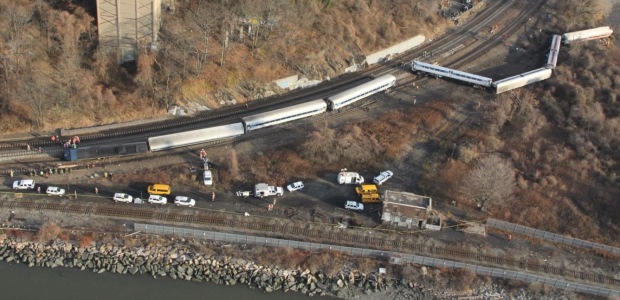
NTSB Cites Ineffective Safety Management in Five Metro-North RR Accidents
One day after New York's Metropolitan Transportation Authority announced it is hiring David L. Mayer, a former NTSB managing director, as its new chief safety officer, the federal agency announced it will hold a Nov. 19 meeting to discuss the safety issues identified in its five investigations.
The National Transportation Safety Board has concluded that five recent accidents involving Metro-North Railroad, part of New York's Metropolitan Transit Authority, were caused by recurring safety issues, "including inadequate and ineffective track inspection and maintenance, extensive deferred maintenance issues, inadequate safety oversight, and deficiencies in passenger car crashworthiness, roadway worker protection procedures, and organizational safety culture." NTSB announced yesterday it will hold a public meeting Nov. 19 at its Washington, D.C., headquarters to discuss the safety issues its investigators identified in these incidents, all of which took place between May 2013 and March 2014.
The five were:
- May 17, 2013, in Bridgeport, Conn., when a Metro-North passenger train derailed and was hit by a second Metro-North passenger train traveling in the opposite direction at 6:01 p.m. At least 65 people were injured. NTSB determined the cause was undetected broken bars used to connect two rails of different heights, and it faulted the railroad's decision to defer scheduled track maintenance.
- May 28, 2013, when a Metro-North passenger train traveling at 70 mph struck and killed a track foreman in West Haven, Conn., at 11:57 a.m. A student rail traffic controller working without direct supervision removed blocking protection for the section of track where the foreman was located. NTSB also faulted Metro-North's "failure to use any redundant feature to prevent this single-point failure."
- July 18, 2013, when several railcars in a CSX freight train traveling on Metro-North's Hudson Line derailed in the Bronx, N.Y. No one was injured; NTSB said the track where the derailment occurred was misaligned and faulted Metro-North's deferral of scheduled track maintenance.
- Dec. 1, 2013, when a Metro-North passenger train derailed in the Bronx at 7:19 a.m., resulting in four deaths and at least 61 injuries. NTSB found that the engineer exceeded the posted speed limit at the location where it occurred and did not apply the brakes because he fell asleep.
- March 10, 2014, when a Metro-North train struck and killed an electrician working on a section of track in Manhattan. He and two co-workers did not correctly understand the limits of on-track protection in place for their work, NTSB concluded, listing "incomplete and inaccurate roadway worker job briefings" as the probable cause of this fatality.
Both NTSB and the Federal Railroad Administration have scrutinized this commuter railroad because of these incidents. "Seeing this pattern of safety issues in a single railroad is troubling," NTSB Acting Chairman Christopher A. Hart said Oct. 28. "The NTSB has made numerous recommendations to the railroad and the regulator that could have prevented or mitigated these accidents. But recommendations can only make a difference if the recipients of our recommendations act on them."
A day earlier, the Metropolitan Transit Authority announced it has hired David L. Mayer, a former NTSB managing director, as its new chief safety officer. It is a new position "created to reinforce safety as the top priority for all MTA agencies as they continue to improve work practices and invest in new technology and equipment," the agency's news release stated. It said Mayer will start Dec. 1 and report directly to MTA Chairman and CEO Thomas F. Prendergast.
"Having someone to oversee and lead safety initiatives throughout the system can only enhance and improve our efforts," said Prendergast. "David's experience with the National Transportation Safety Board, and exceptional work on safety projects in all modes of transportation, makes him the best person for the job."
The release said Mayer will work closely with Metro-North Railroad Chief Safety Officer Anne Kirsch, Long Island Rail Road Chief Safety Officer Loretta Ebbighausen, New York City Transit VP System Safety Cheryl Kennedy, VP Safety Programs and Initiatives at MTA Bridges and Tunnels James Foley, and MTA Capital Construction VP of Safety Peter Kohner. "I'm excited to join a transportation network that is focused on promoting a safety culture while constantly looking for ways to improve its practices. I look forward to the challenge of proactively serving a population of over 15 million people," Mayer said.
He joined NTSB in 1991 in its Office of Research and Engineering, later being named assistant managing director and then managing director in 2009, according to the release, which said Mayer headed more than 50 major investigations while with the agency.